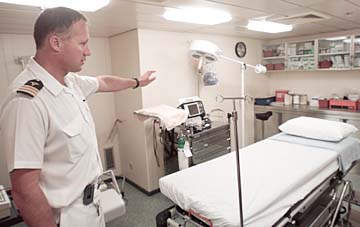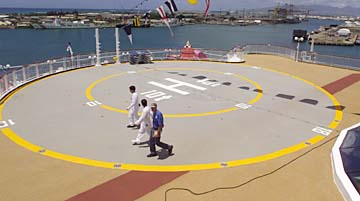


|
During the six years Izak Van Niekerk has worked as a doctor for Norwegian Cruise Lines, he has only had to treat people rescued from other boats on two occasions. Cruise ship’s crew takes
pride in 2 recent rescuesBy Treena Shapiro
tshapiro@starbulletin.comBoth happened in the past three weeks.
Serious emergencies are common aboard the Norwegian Star, Van Niekerk said, but rescues at sea are something else. "It's supposed to be rare," he said with a smile.
On April 2 the cruise ship rescued 11 crew members of the Insiko 1907, an Indonesian tanker that had been gutted by a fire that killed one crew member and left another badly burned.
On Tuesday the crew of the Norwegian Star was called on once again, this time to pick up a 65-year-old man from a yacht for an undisclosed medical condition. The Coast Guard had initially reported that the victim was suffering from a urinary tract infection, but Van Niekerk said that was incorrect.
"It felt great," Van Niekerk said. "It's nice for us to be able to do something for somebody. I think all of us got a bit of a kick out of it."
The Honolulu-based cruise ship sails around the Hawaiian Islands and to Fanning Island in the Republic of Kiribati on a weekly basis.
The ship carries about 3,800 passengers and crew members representing 60 countries, said Van Niekerk, who is from South Africa.

|
The medical staff -- two doctors and three nurses -- treats about 250 people a week, often for sea sickness or colds, but also for more serious ailments.Their medical center houses an operating room, a two-bed intensive care unit, a two-bed recovery room and a fully stocked pharmacy. It is equipped with X-ray machines, defibrillators, EKG machines and tanks of oxygen.
The one thing it lacks is blood, because there is no way to store it and the staff does not have the equipment needed to test patients' blood types.
"We don't view our medical center as a replacement to proper shoreside facility. And that's why we always transfer somebody who is really sick," Van Niekerk said.
The Norwegian Star's medical staff often must make the call whether a patient's condition can be stabilized until the ship reaches shore or if the ship should be redirected to reach the nearest onshore medical facility.
If the ship is in helicopter range, they also must decide whether the patient's condition warrants a risky helicopter ride. Since the ship has a helicopter landing pad on one of its decks, helicopter transport is safer than when a patient must be hoisted up in a basket, Van Niekerk said.
Luckily, "more than 60 percent of the time, we are close to land," and the longest the medical staff would need to keep the patient stabilized is three days, he said.
Registered nurse Nancy Hertlein has had more experience at making ocean rescues over the 18 years she has worked for Norwegian Cruise Lines, but she estimates that she has only been present for six or seven medical rescues.
"It feels really good. You can't imagine how they must feel when they're out floating around for that long, not knowing whether someone is going to come out and help them."
In between the two rescues, the medical staff had to treat a passenger who had suffered a heart attack and needed a pacemaker -- a situation more serious than the men they brought aboard, but Hertlein, a former emergency room nurse, said there was an element of excitement to the rescues.
"It really makes you feel like you're doing something out of the ordinary," she said.
While praised for rescuing the Insiko crew, the Norwegian Star staff, particularly the captain, has been criticized for leaving a dog behind on the Insiko, a situation that has left them all saddened.
"I don't think there's one single person on this ship that's not concerned about that," Hertlein said.
Norwegian Star officials have maintained that the crew did not know about Forgea the dog until it was too late.
While happy to hear the dog had been found alive yesterday, Hertlein pointed out, "You have to remember there's also a dead body on that ship that hasn't been recovered as well, but nobody seems to be paying attention to that."